How to Create A Marketing Consultant Proposal to Win More Clients (Template)
 Are you getting enough marketing consulting clients?
If not, the problem could be your marketing consultant proposal.
Maybe you’ve been hustling hard, but you just can’t seem to close the deal. A good marketing consultant proposal can do that for you.
Conversely, a weak marketing consultant proposal can leave serious questions about your capabilities as a marketer. After all, marketing is all about persuading people to buy a product or service.
Fortunately, with a few small tweaks, you can get back on track.
Here you will learn how to take the right approach and create a killer marketing consultant proposal to land more clients. Plus, you’ll get a marketing consulting proposal template to follow along, so there’s no way you can go wrong.
Are you getting enough marketing consulting clients?
If not, the problem could be your marketing consultant proposal.
Maybe you’ve been hustling hard, but you just can’t seem to close the deal. A good marketing consultant proposal can do that for you.
Conversely, a weak marketing consultant proposal can leave serious questions about your capabilities as a marketer. After all, marketing is all about persuading people to buy a product or service.
Fortunately, with a few small tweaks, you can get back on track.
Here you will learn how to take the right approach and create a killer marketing consultant proposal to land more clients. Plus, you’ll get a marketing consulting proposal template to follow along, so there’s no way you can go wrong.
How to Create A Marketing Consultant Proposal to Win More Clients (Template) by @JuliaEMcCoy via @CoSchedule
Click To TweetDOWNLOAD: Marketing Consultant Proposal Template
Put together detailed proposals that win more clients with this Microsoft Word template. It makes it easy to fill in your information and create an attractive deliverable without having to make your own from scratch. Combined with the expert guidance in this post, you'll have everything you need to get started.What Makes a Great Marketing Consultant Proposal?
Before you learn about exactly what you should include and what to leave out, we want to give you a sense of what makes a great marketing consultant proposal. Some key considerations for winning the bid are as follows. You can also make use of CoSchedule's Proposal Generator that makes custom and professional proposals! Source
Source
Define Success For Your Client (And Stay Focused On It)
Never forget, the proposal is all about the client. Too many marketers wrongly try to show off all their credentials in the proposal, instead of focusing on the client. Focusing on the client means defining their goals, obstacles they face, and making sure to link each solution you suggest to their goals. Keep in mind that that the person who can describe the problem best is trusted most to solve it. If you can accurately describe the problem and paint a convincing picture to the solution, then you will win the bid. Make sure you define the client’s success using metrics like dollars or other measurable outcomes. This helps both parties know what to expect and to determine if the plan is successful as you progress in your relationship.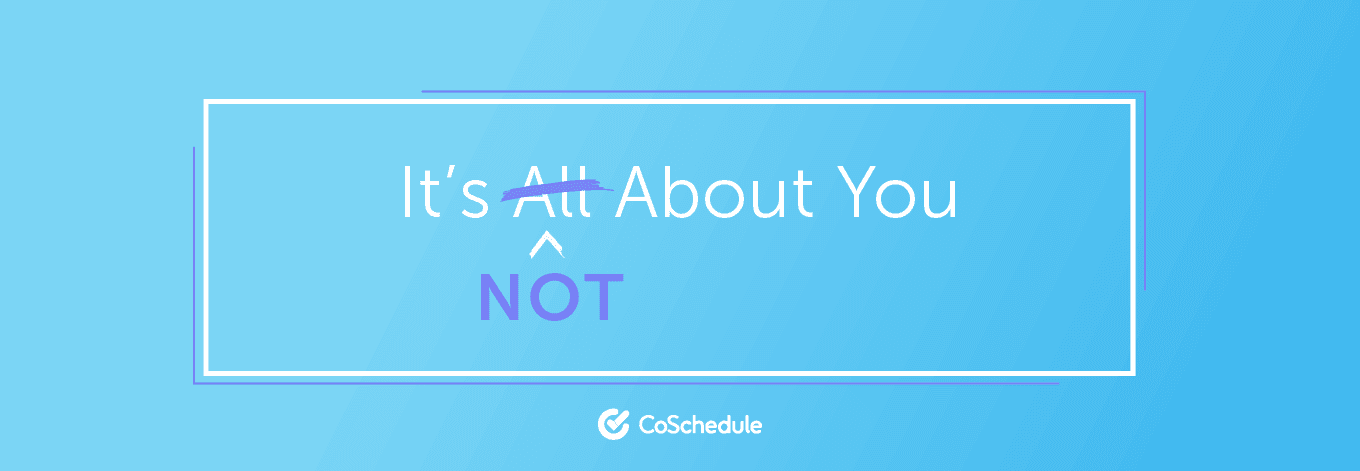
Don’t Provide Unnecessary Information
This is a proposal, not a contract. Don’t get bogged down in unnecessary information. Remember that this is a sales document intended to sell your solution to your client. As such, focus on the benefits your clients will receive, and position yourself as the ideal marketer to make those benefits happen.
Don’t get caught up in every detail of the arrangement. Keep it concise and to the point, while still providing the necessary details to allow your prospect to understand the value of the arrangement.
Correct formatting helps make sure that your approach is streamlined and accessible. The marketing consulting proposal template included in this post ensures that you include only the necessary information, without bogging your prospect down in unnecessary details.
This video is a bit long, but it offers great insight into how to communicate with new clients effectively:
Remember that this is a sales document intended to sell your solution to your client. As such, focus on the benefits your clients will receive, and position yourself as the ideal marketer to make those benefits happen.
Don’t get caught up in every detail of the arrangement. Keep it concise and to the point, while still providing the necessary details to allow your prospect to understand the value of the arrangement.
Correct formatting helps make sure that your approach is streamlined and accessible. The marketing consulting proposal template included in this post ensures that you include only the necessary information, without bogging your prospect down in unnecessary details.
This video is a bit long, but it offers great insight into how to communicate with new clients effectively:
Communicate Clearly in Plain Language
Along the same vein as keeping your proposal concise, make sure you don’t use too much jargon. Be sure to put everything you do into a context that your potential client can understand. This helps them grasp the value that you provide. Here’s a tip: your value isn’t that you can run PPC ads or set up a Facebook page. Your value is that you can earn the prospect more clients by communicating their message to the people that need to hear it. As much as possible, keep everything in the proposal in these terms.Submit Your Marketing Consultant Proposal Earlier
Research shows that winning service proposals get to clients 26% faster.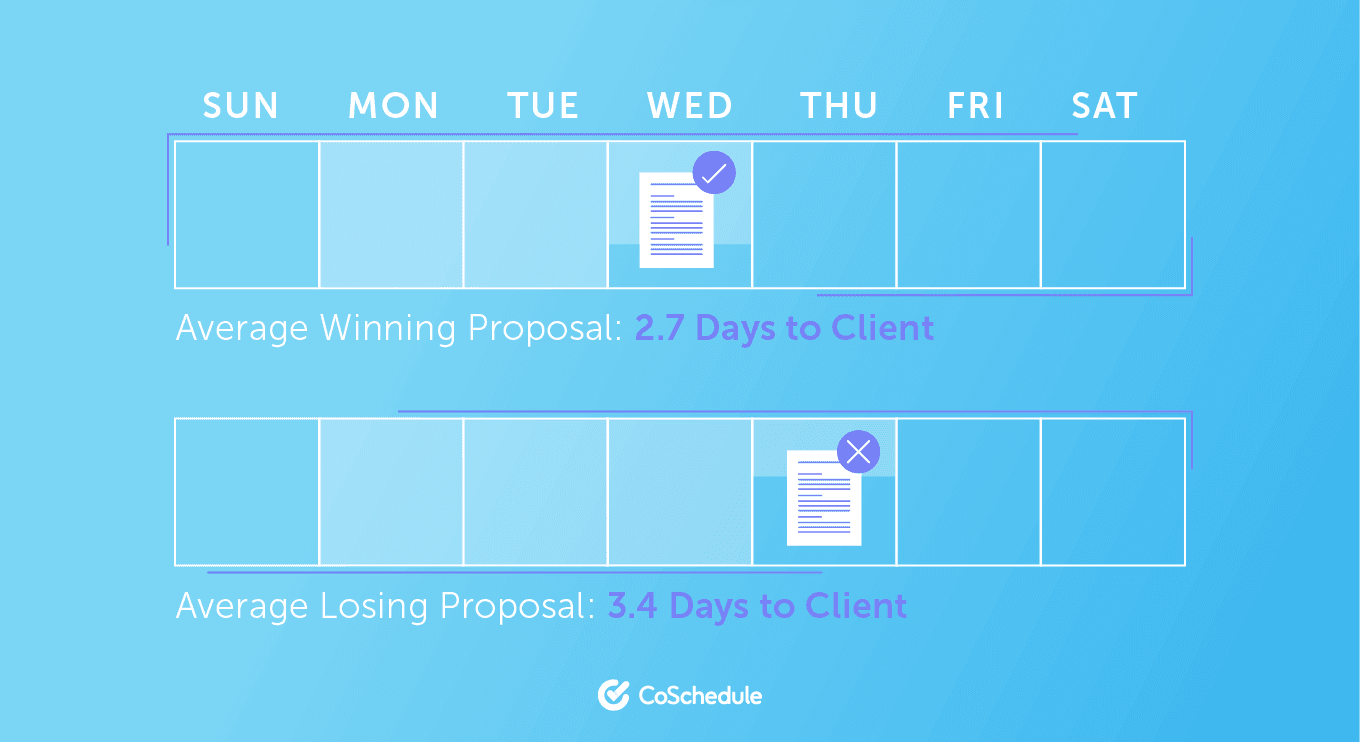 Interestingly, the difference in turnaround time between the average winning proposal (2.7 days) and the average losing proposal (3.4 days) was less than 24 hours. Speed seems to help your bid get accepted.
How long do you have to send off your proposal? Aim for no more than 2-2.5 days.
Interestingly, the difference in turnaround time between the average winning proposal (2.7 days) and the average losing proposal (3.4 days) was less than 24 hours. Speed seems to help your bid get accepted.
How long do you have to send off your proposal? Aim for no more than 2-2.5 days.
The Anatomy of An Outstanding Marketing Consultant Proposal
While each client’s needs are unique, a winning proposal follows the same formula, regardless of the services offered.1. Goal Statement
From previous interactions with the prospect, you should know what their goals are. This is the starting point of every good proposal.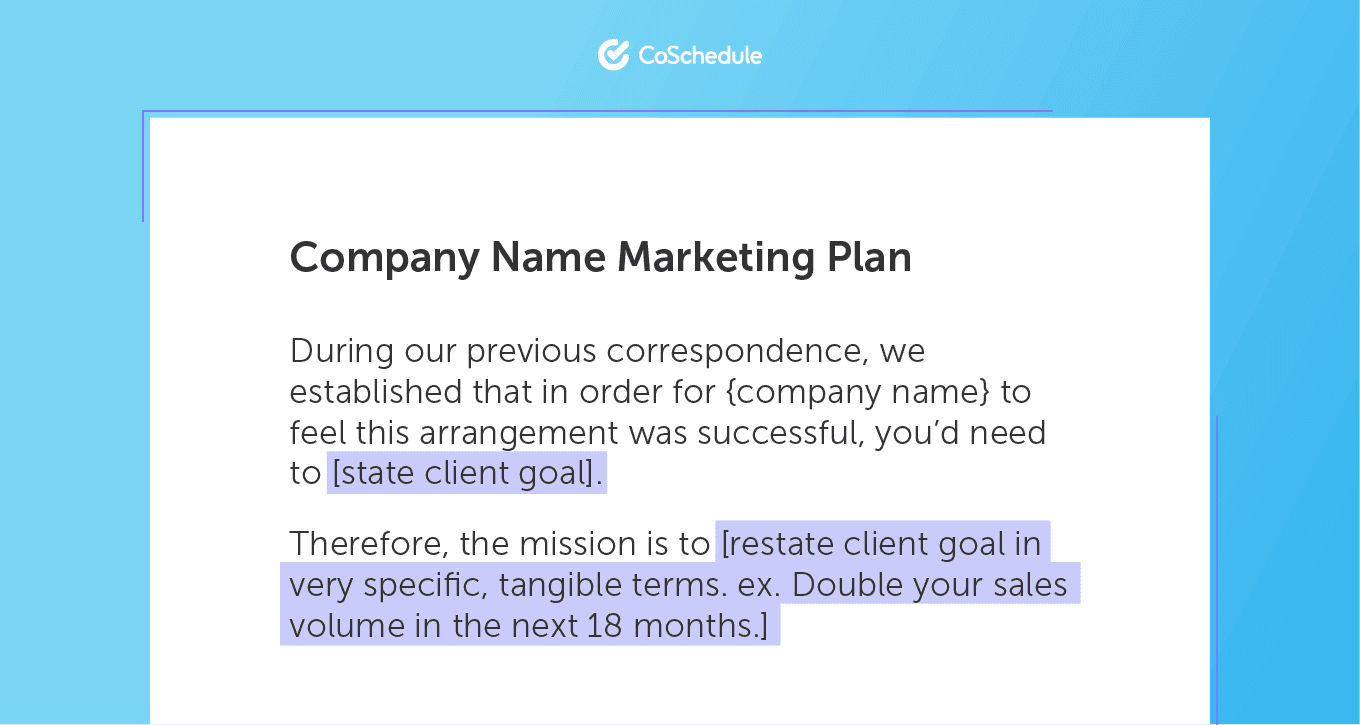 Show that you understand your client by telling them that you are going to help them reach their goals. It’s good practice to state goals in terms of their business, such as increasing their sales or revenue. Then, you can continue on to state marketing goals, and how reaching them ties in to reaching the business goals.
If you don’t know what your client’s goals are, find out by asking. You must do this, as it will make or break your proposal.
Show that you understand your client by telling them that you are going to help them reach their goals. It’s good practice to state goals in terms of their business, such as increasing their sales or revenue. Then, you can continue on to state marketing goals, and how reaching them ties in to reaching the business goals.
If you don’t know what your client’s goals are, find out by asking. You must do this, as it will make or break your proposal.
2. Problem Statement(s)
Next, identify what is stopping them from reaching their goals. Describe the problems your prospects face in detail. Why have they failed to reach their goals? Provide a detailed analysis of their specific problems. Include information about the client’s competitors and show that you understand their client’s personas.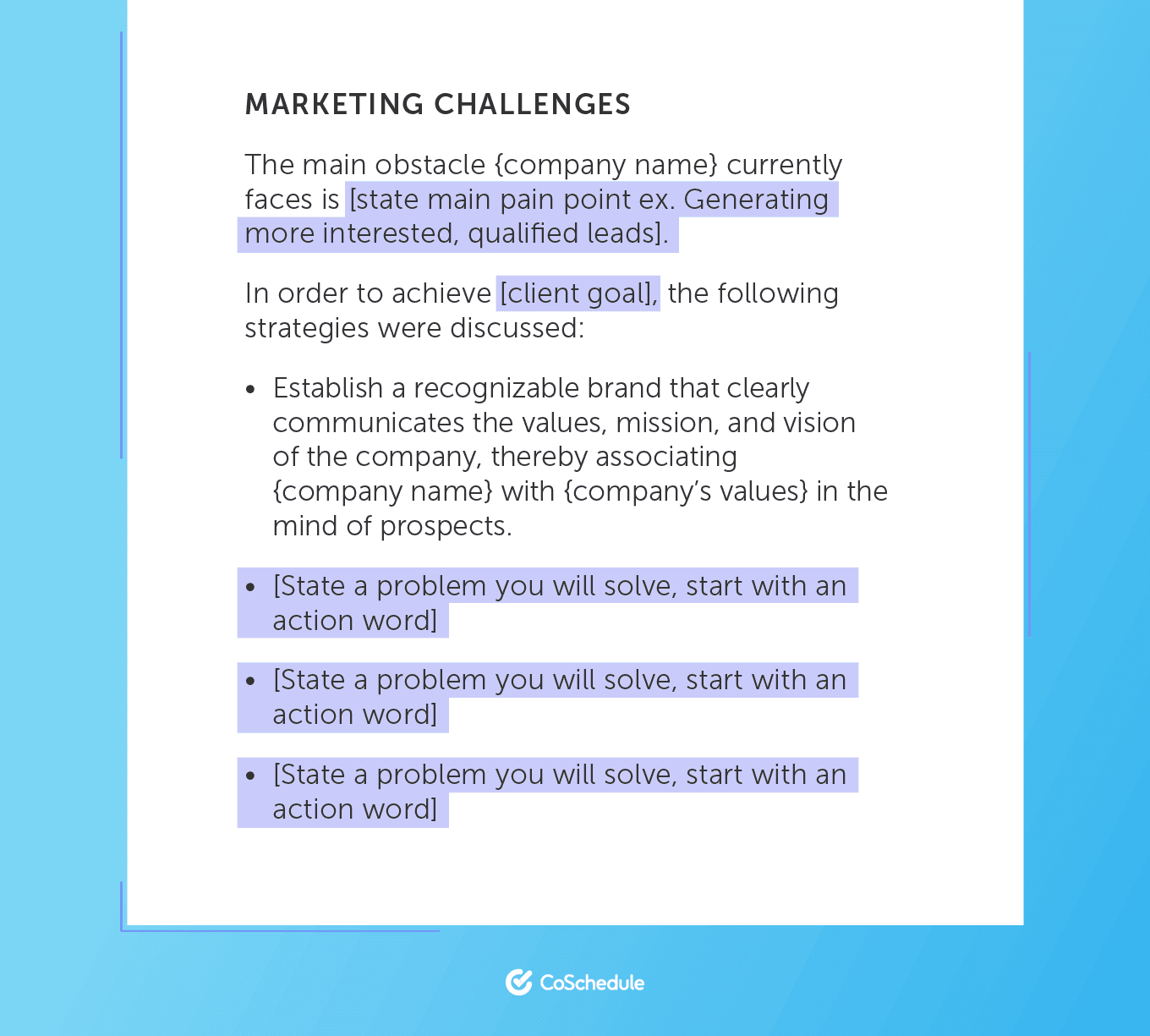 Use positive language as much as possible, to avoid sounding overly critical and to communicate that you are optimistic about their future (with you!). Plus, it makes you seem more pleasant to work with.
Use positive language as much as possible, to avoid sounding overly critical and to communicate that you are optimistic about their future (with you!). Plus, it makes you seem more pleasant to work with.
3. Recommended Solution(s)
In this section, clearly communicate the intention of your plan and provide an overview of what it entails. The solutions you recommend here will give the client a general sense of what is going to happen. Later, you will follow up by addressing each issue you brought up in the problem section one by one. For now, address how you will approach the problem. Give an overview of what is involved in your plan, including the goals of each phase.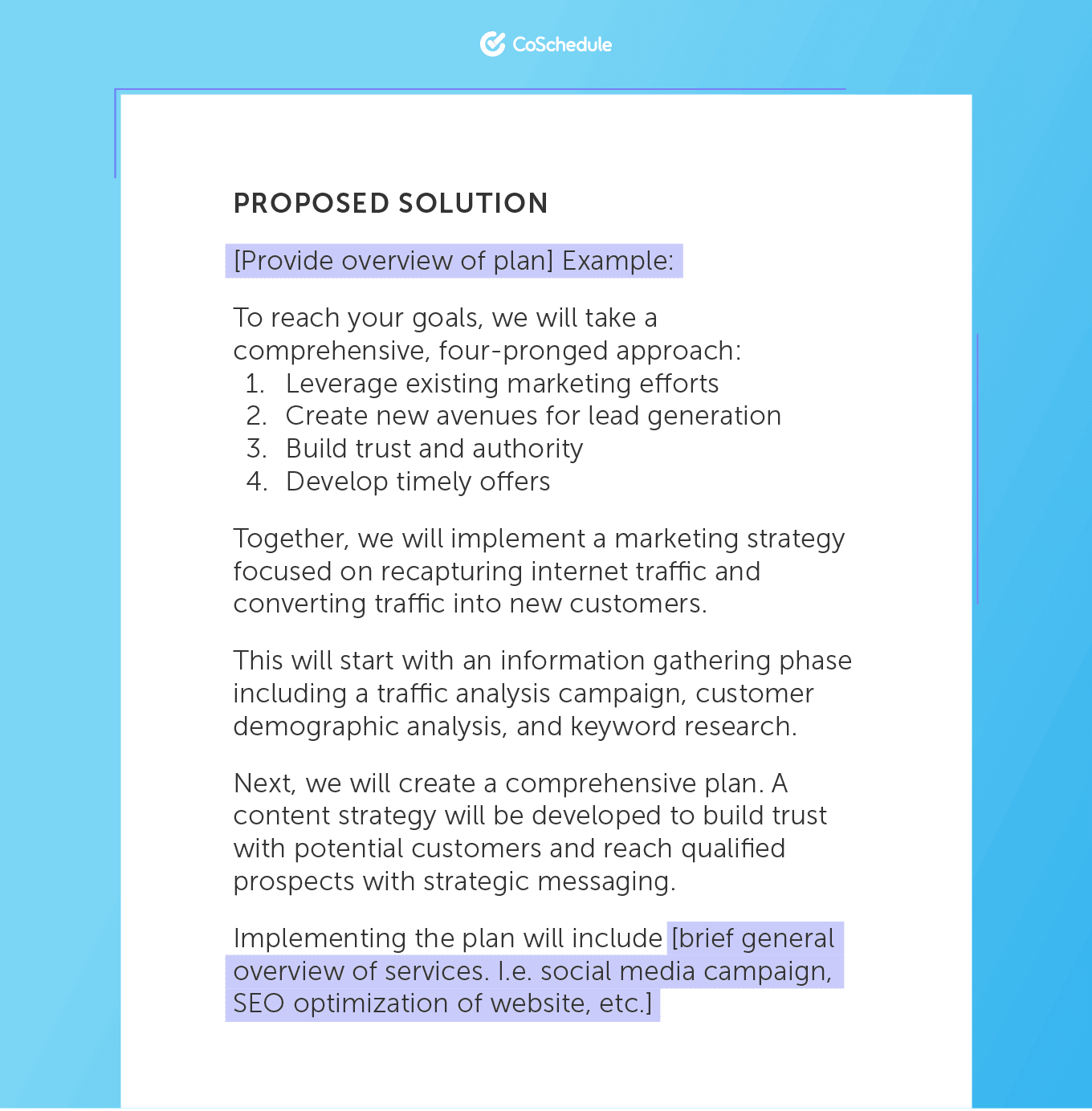 Introduce the client to the services they will be receiving and set the context of what is going to happen.
Introduce the client to the services they will be receiving and set the context of what is going to happen.
4. Delivering Results
The results section allows you to hone-in on specific results that you will produce for your client. This is the section where you address each problem you identified that is stopping the client from reaching their goals.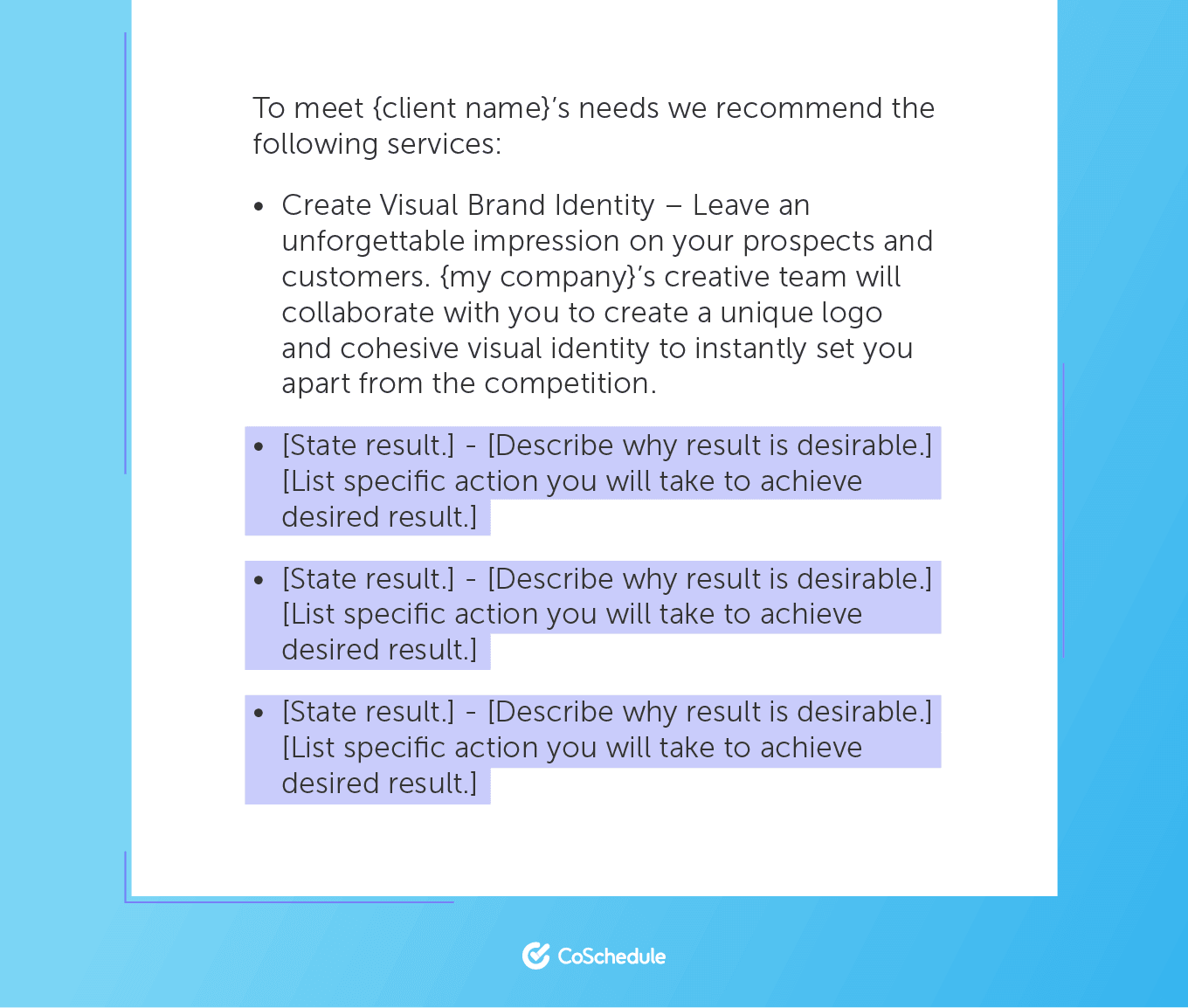 Remember, don’t just say what you will do, explain why you will do it and relate the reasons to objectives the client cares about.
For example, don’t just say “we will use PPC to generate leads”, say instead, “we will use targeted messaging on Google’s advertising platform to reach specific customers who are most likely to be interested in the product.”
You can even use language that relates specifically to the customer’s business: “we will use targeted messaging on Google’s paid advertising platform to reach fishermen who have visited the store in the last 12 months”.
Remember, don’t just say what you will do, explain why you will do it and relate the reasons to objectives the client cares about.
For example, don’t just say “we will use PPC to generate leads”, say instead, “we will use targeted messaging on Google’s advertising platform to reach specific customers who are most likely to be interested in the product.”
You can even use language that relates specifically to the customer’s business: “we will use targeted messaging on Google’s paid advertising platform to reach fishermen who have visited the store in the last 12 months”.
5. Why Choose Us?
As a marketer, you probably already know that benefits are best communicated using a “show, don’t tell” approach. That’s what this section is for. The Why Chose Us? section gives you an opportunity to brag about previous results. In this section, you should show why you’re better than the competition. Include previous results you’ve created for clients. Showing prospects previous results creates trust in your capabilities and helps to remove objections around buying your services. You can also use this section to tell the prospect directly why they should hire you over all the other options out there. Consider introducing yourself and your organization to give your prospect a feel for what they can expect when they work with you.6. Project Fees And Timeline
Now, it’s time to fill in the details on the scope of the project. Include estimated dates of completion for each phase of the project along with the total investment they will be making for your services. When it comes to pricing your work, keep it relatively general - remember it is not a contract, and you can always specify the details later on. There are a couple of reasons you want to stay general on this, rather than itemizing each service. First, it’s unlikely that you will have a clear idea of the exact services you will need to provide until you start working with the client. To avoid unnecessary back tracking later, it’s best to stick to the general idea of what you will be doing, rather than listing each service individually. Additionally, staying general provides the added benefit of allowing you to price your services as a package. If you itemize the price of each service, your proposal will quickly seem overwhelming to the reader. Remember, this is a sales document, not a contract. So, you want it to be as neat and easy to understand as possible. Packaging services together avoids unnecessary confusion and prevents clients from asking for individual services to be removed (often to their own detriment). State your timeline in terms of phases to help the client see the value of working with you over a determined period. By stating the phases of your plan and what’s involved in each step, you justify your price.
State your timeline in terms of phases to help the client see the value of working with you over a determined period. By stating the phases of your plan and what’s involved in each step, you justify your price.
7. Call to Action
Finally, conclude your proposal with a short note explaining what happens next.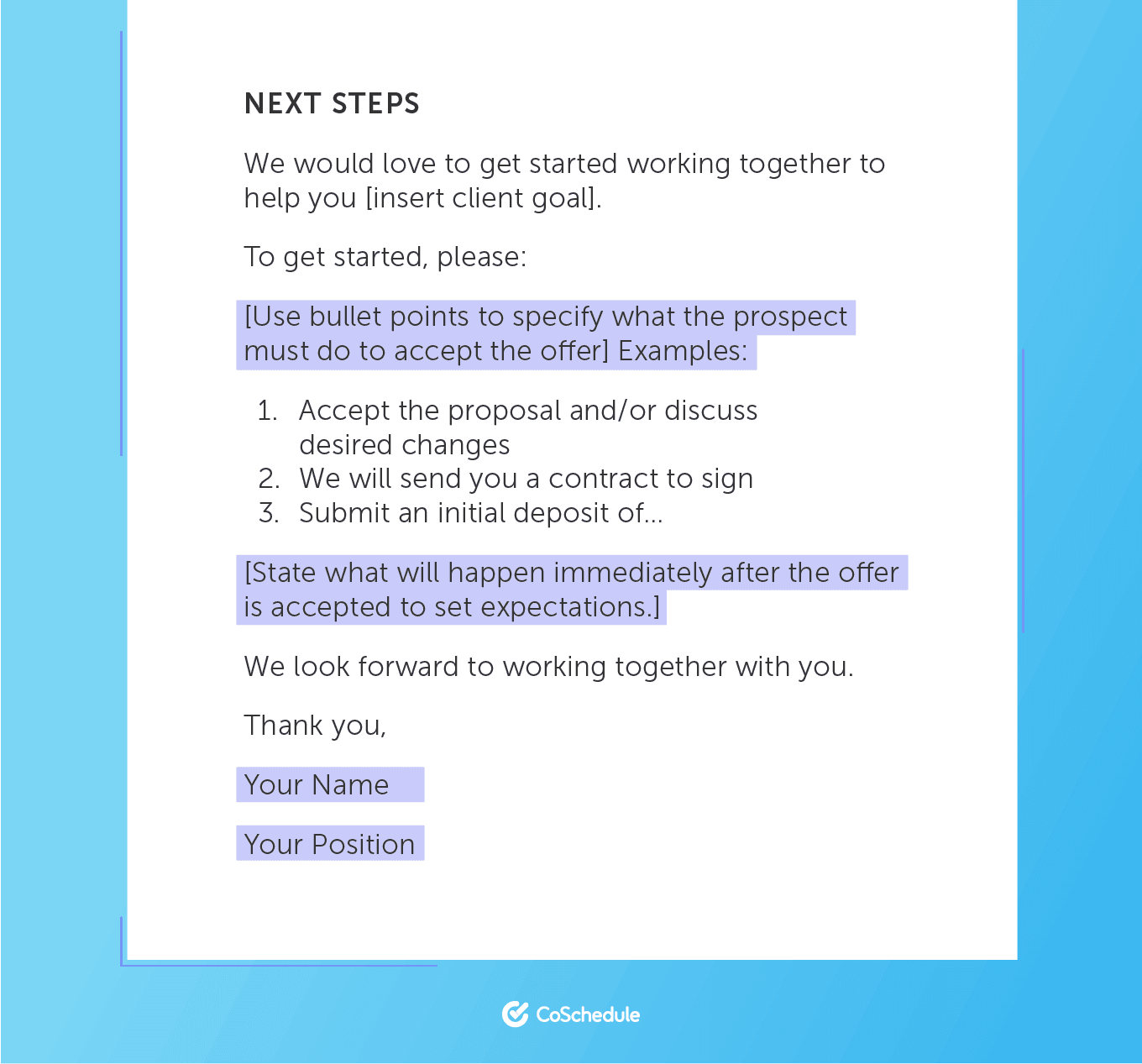 This section should include next steps for the client to take if they want to move forward, which often includes signing a contract and sending an initial deposit.
You want to get the prospect to buy in to the idea of working together, so explain to them what will happen immediately after they send the required documents and payment.
Some people like to include an expiry date on their offer to encourage timely decisions by the prospect. If you would like to do that, this is the section to specify how that works.
Note: if you would like to have the client sign the proposal as the indication to start work, it would be prudent to include a “Terms and Conditions” section at the end of the proposal to make sure both parties are on the same page.
This section should include next steps for the client to take if they want to move forward, which often includes signing a contract and sending an initial deposit.
You want to get the prospect to buy in to the idea of working together, so explain to them what will happen immediately after they send the required documents and payment.
Some people like to include an expiry date on their offer to encourage timely decisions by the prospect. If you would like to do that, this is the section to specify how that works.
Note: if you would like to have the client sign the proposal as the indication to start work, it would be prudent to include a “Terms and Conditions” section at the end of the proposal to make sure both parties are on the same page.


